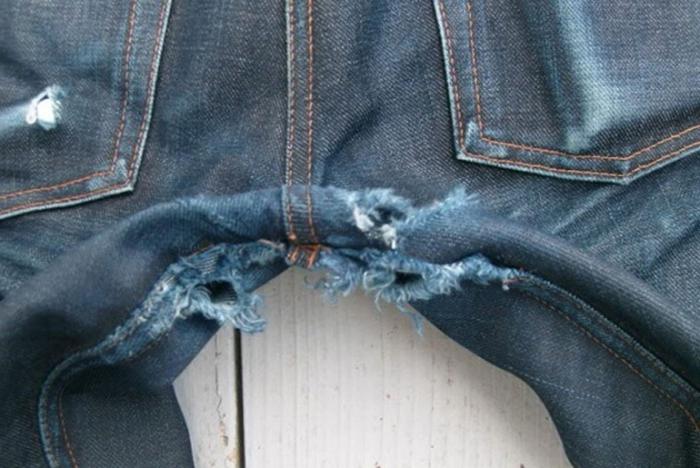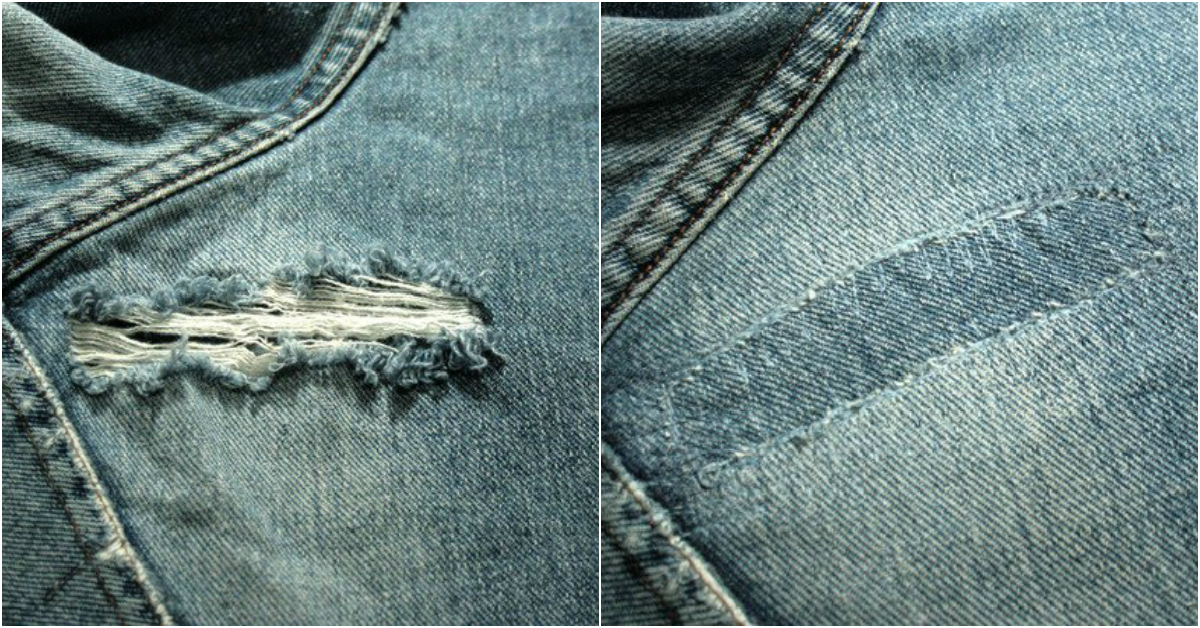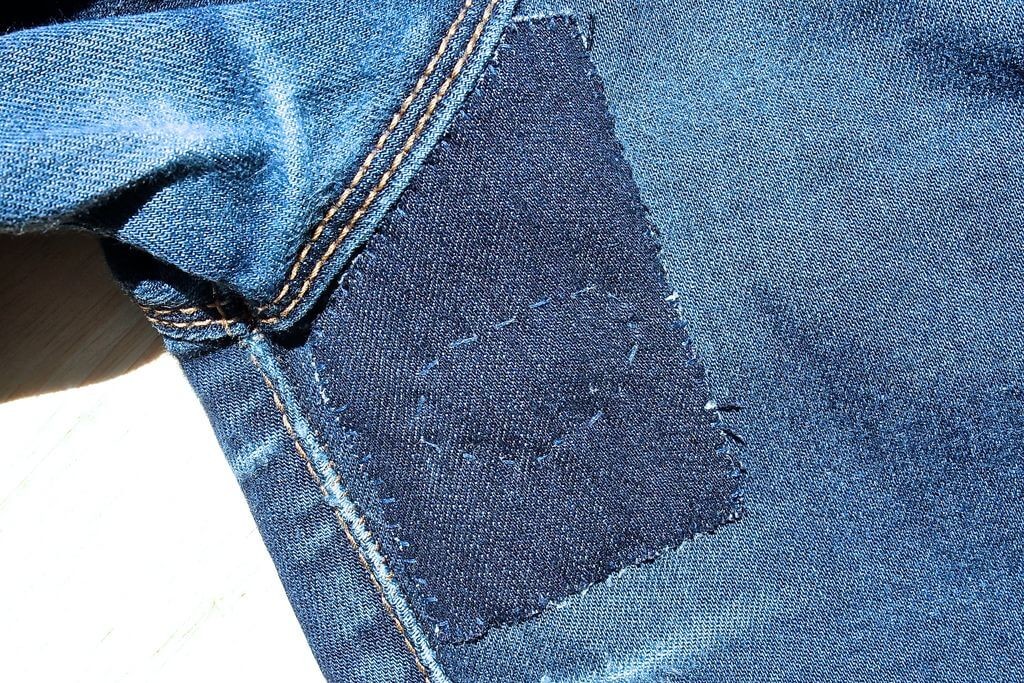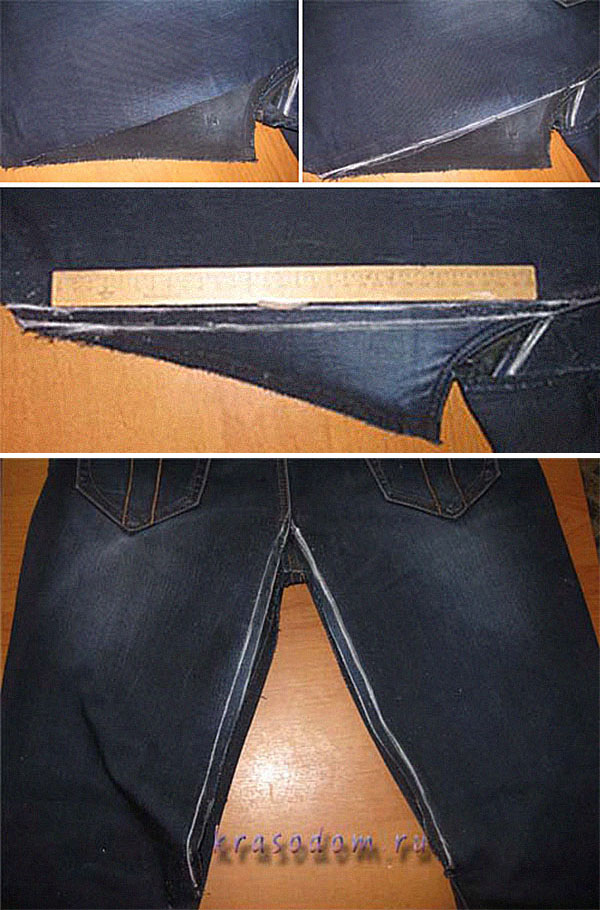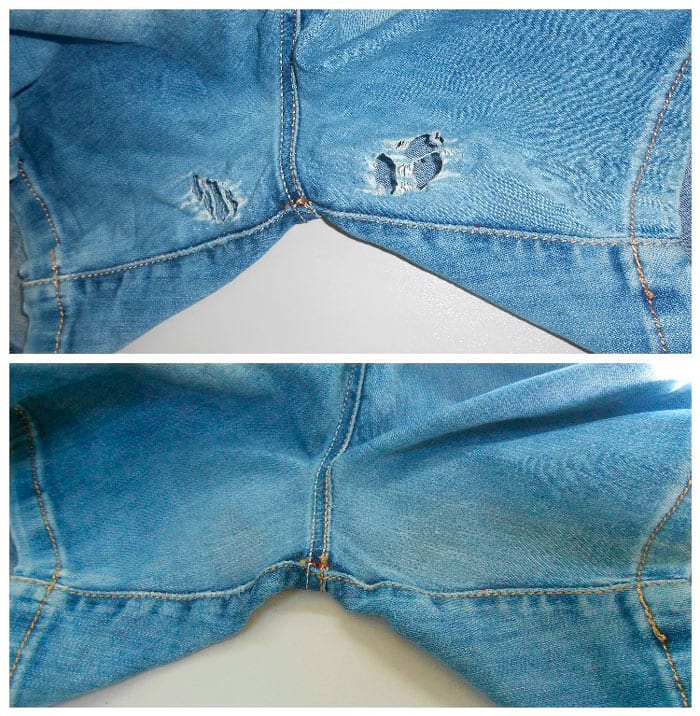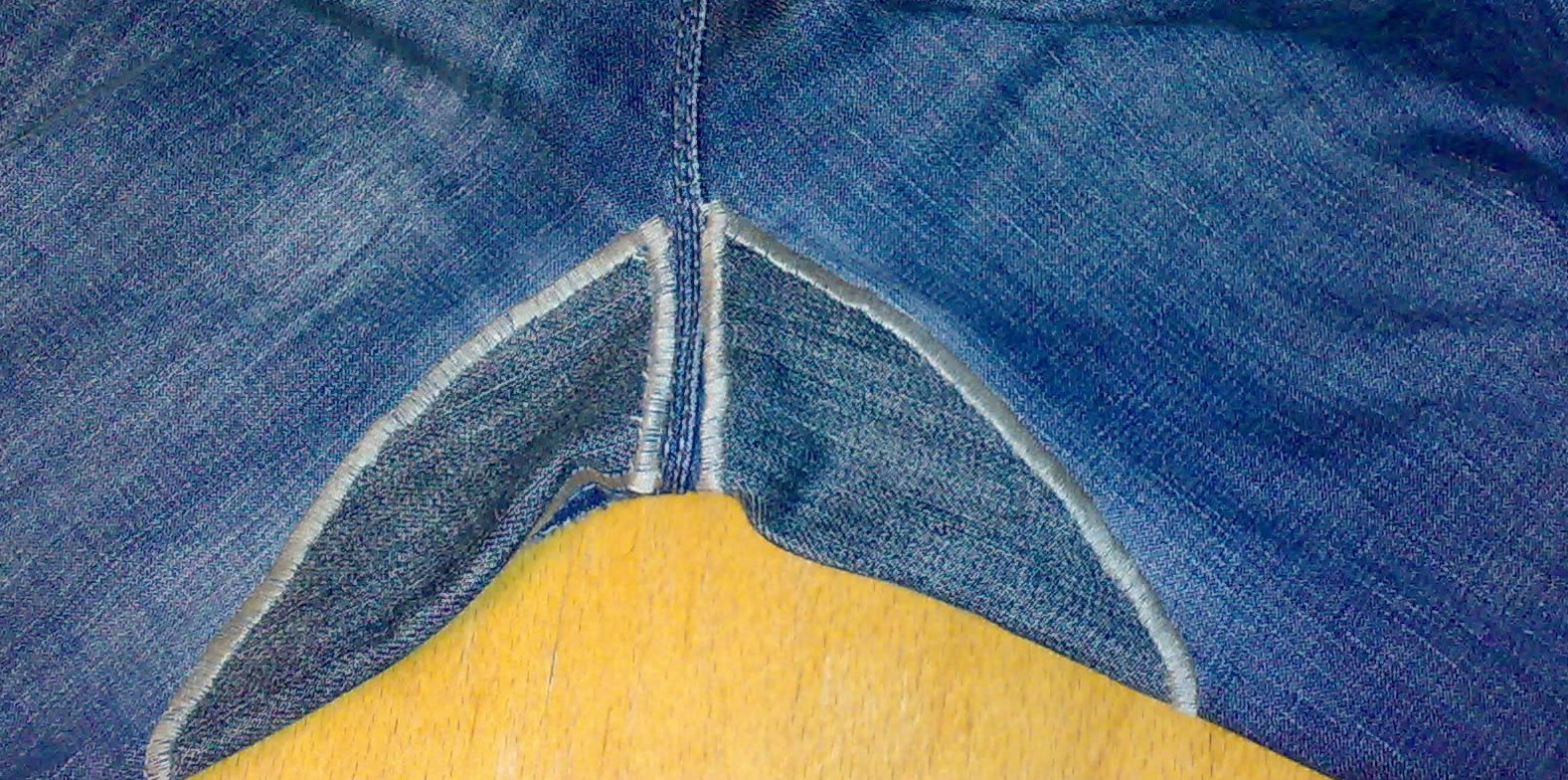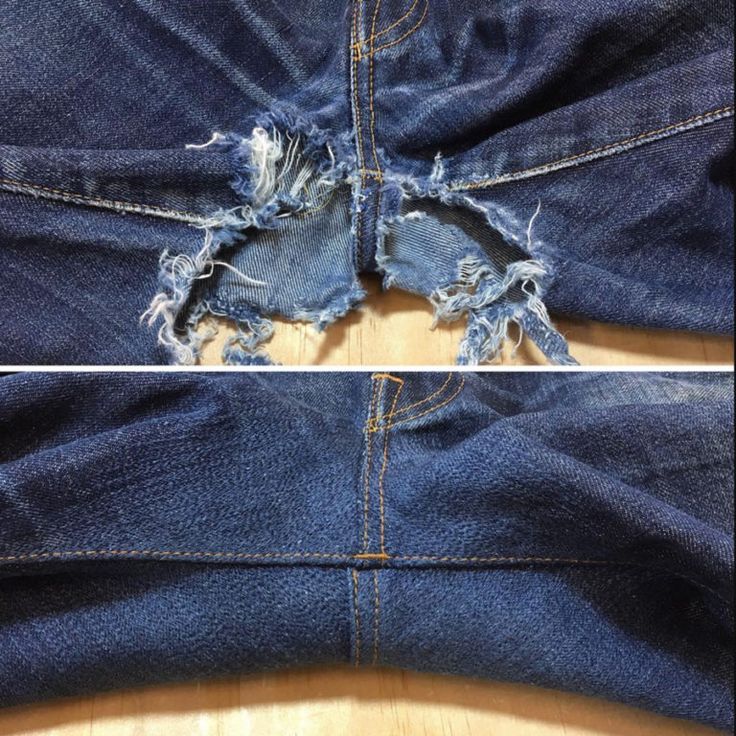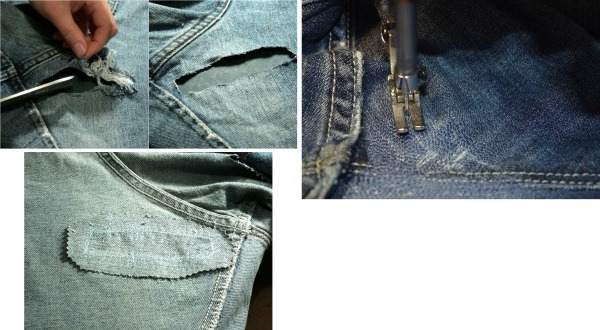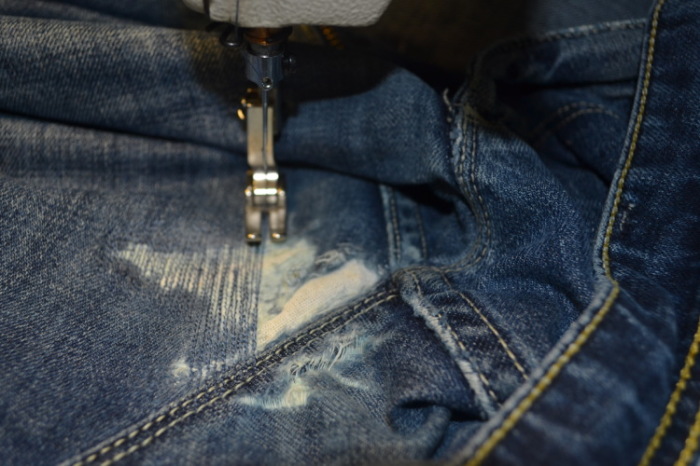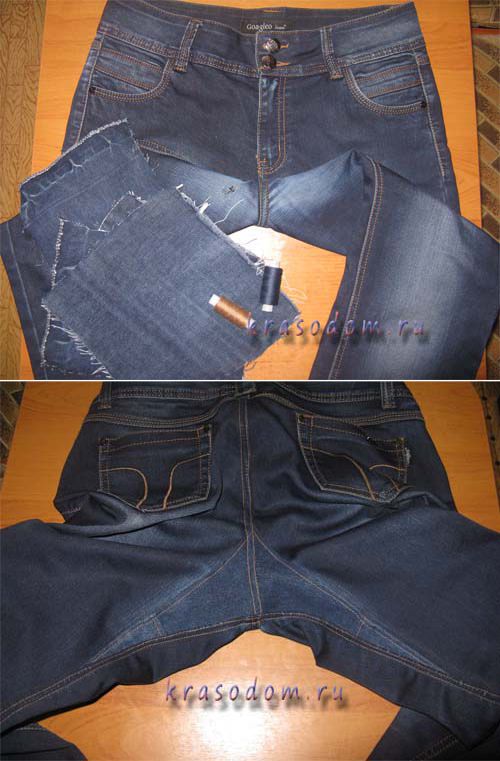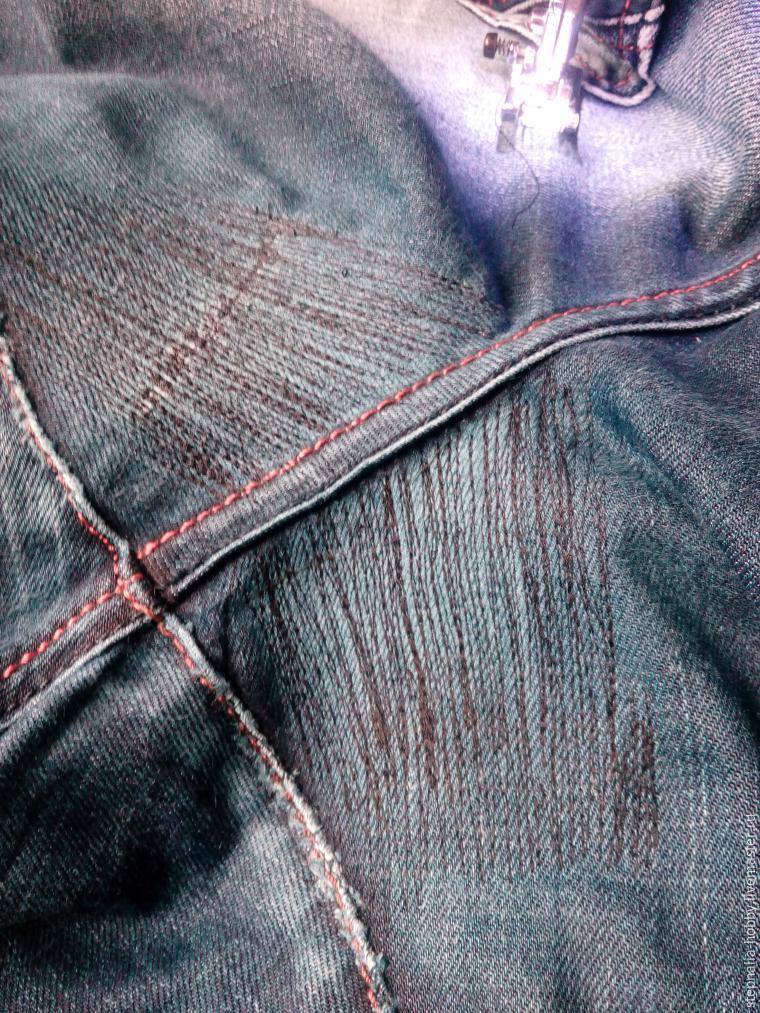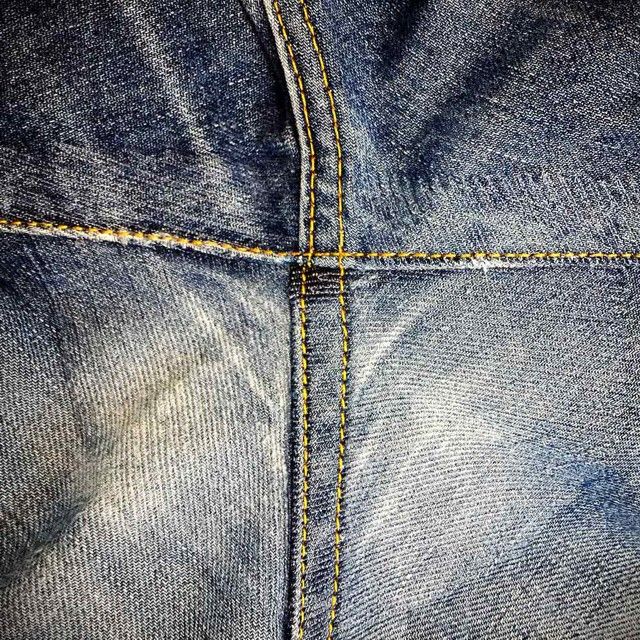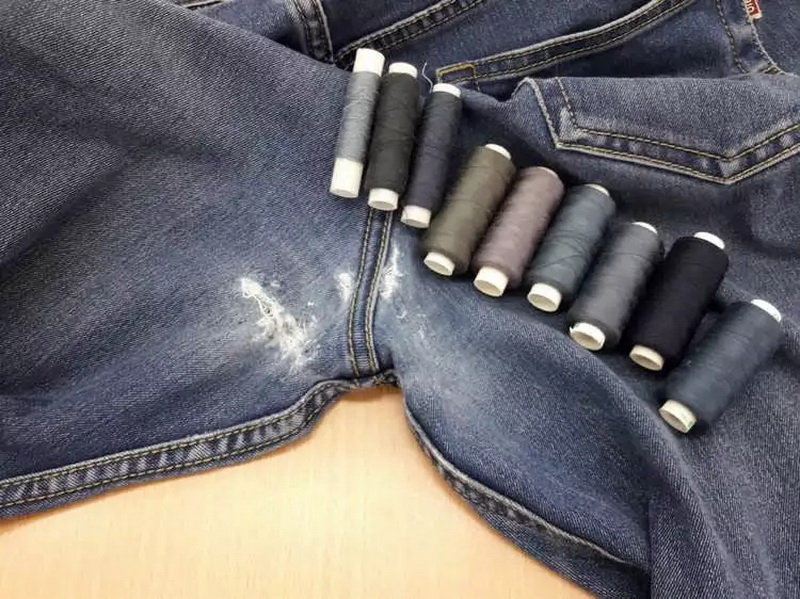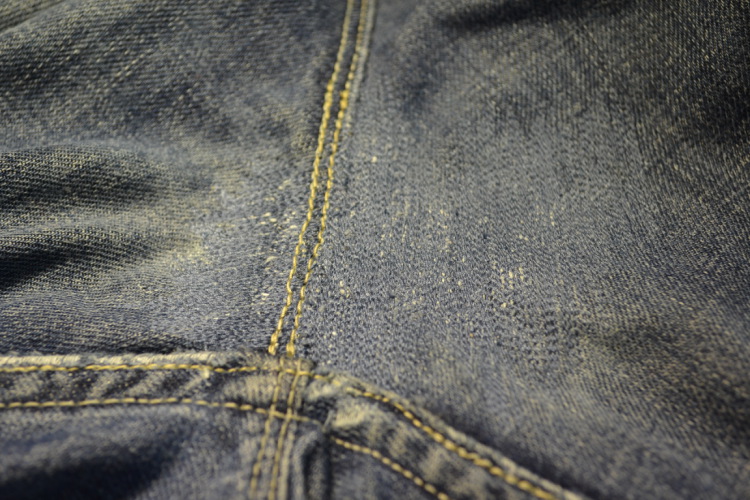Problem solving methods: manual, "machine"
The simplest ways to extend the "life" of a favorite thing by how many months are to apply a patch on the inside of the product, and on the outside - to form the thickest stitching that will imitate the threadlike weave of the fabric.
Manual method number 1

What is needed for implementation:
- soft fabric, which will play the role of the patch itself (it should not be loose - doublerin on glue and fabric backing will do);
- strong thread for sewing;
- scissors, needle, chalk.
Repair process:
- Wash, dry the product, smooth it so that there are no wrinkles at the top.
- Turn the jeans inside out.
- If there is already a hole in the problem area, sew it up manually.
- From the patching fabric, form a piece to fit. It should completely cover the abrasion. Add 1.5 cm on all sides.
- Secure the patch with an iron or basting.
- Turn the product to the right side, form the lines with your hands parallel to the denim.
- Try to place them as close to each other as possible.
- After one side is “ready”, turn the fabric over and continue sewing until the entire damaged part is covered.
- Do all of the above with the other leg.
Manual method number 2

This involves sewing on a denim insert of a similar color. What is necessary:
- a piece of denim;
- two threads: 1) in color with jeans, 2) to match the seam on the pants.
- Needle, scissors, ruler, chalk, steam iron;
- Paper and pen.
Implementation:
- Wash the product, and the patch, iron thoroughly with an iron.
- Using your nail scissors, cut all the seams all the way down to the middle.
- With a piece of soap or chalk, make a markup - you need to understand which part you need to cut off (the damaged area should be behind this line).
- Take a ruler, draw straight, parallel lines on two legs. For a seam allowance, draw a second line - 1.5 cm further.
- Cut the fabric along the first lines, if it turns out unevenly - correct it.
- Attach the resulting pieces of fabric to a sheet of paper, circle with a pencil, cut off the necessary flaps - make an insert pattern.
- In the place where the flap will be sewn to the pants, leave 1.5 cm for the seam.
- Attach the resulting pattern to denim, circle with chalk, cut off.
- For a parallel leg, make a mirrored piece of fabric.
- Baste the tabs to the jeans as evenly as possible, then sew them with blue threads. Seams - in color that matches the factory.
If it was not possible to beautifully restore the product, then, alas, after all these manipulations it will have to be sent to the trash heap. Therefore, before starting, you should think carefully and assess your capabilities.
A way to sew a hole between your legs using a sewing machine

If you have a sewing machine, you will have to work a little more seriously, as you will need additional knowledge and experience in sewing. If there are any, then on your jeans with a frayed or a hole you will not even notice a trace of the problem.
What should be done:
- Stretch the fabric as tight as possible so that there are no seams on it. This is the main rule to follow when sewing a line.
- The seam should be vertical to match the structure of the denim as much as possible. So it will turn out to "veil" the hole as imperceptibly as possible.
- The patch is applied only in a zigzag pattern.
- If you don't have a thread to match the color of your jeans, you can take two similar colors and combine them - it will be lighter in the game, and darker in the bobbin.
- The resulting hole needs to be masked using the "gizmo" method.
Conclusion
Which method to choose is up to you. But do not forget to remember your abilities in relation to your sewing skills. All seams should be as beautiful and even, neat as possible. Otherwise, you will have to say goodbye to your favorite thing forever.
How to keep jeans from rubbing: 7 valuable rules
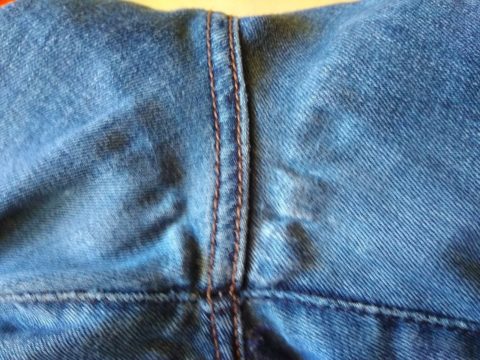
To avoid such a problem, it is worth adhering to a few simple rules:
Rule 1
If the problem with holes between your legs is a constant, then when going to the store for a new pair of pants, always choose the right size. In the inner thighs, the legs should not be too taut. Optimal is to buy a product for a larger size.
Rule 2
If you are overweight, try to lose it. This will not only save you from the problem of a constantly rubbed crotch on your pants, but also have a positive effect on your health. If you are overweight, none, even the most expensive and high-quality pants, will last you long.
Rule 3
Jeans with a high or regular fit are wiped less frequently. If they are normally pulled up and firmly fixed, then the fabric in the area between the legs will not have folds, that is, stripes and holes will not appear. Try not to buy low-waisted models.
Rule 4

If you spend most of your time in a sitting position, try to constantly control your movements. If you want your pants to last as long as possible, try to raise yourself slightly when changing positions while sitting on a chair. This will significantly reduce the rate of wear of the item.
Rule 5
Try to take proper care of your jeans. Don't throw them in the wash too often. And in the process of cleaning, wash either by hand, or set the most gentle mode on the typewriter. Fasten all buttons, zippers, and turn the garment inside out before washing.
Rule 6
If the problem with crotch holes is persistent, then try to keep an eye on this area on your pants all the time. As soon as you notice that the first signs of "rubbing" appear, do not wait - take your jeans to the sewing workshop. Alternatively, seal the fabric yourself.
Rule 7
If you only wear jeans, get several pairs at once, and try to alternate them. You can buy 3-4 pairs for socks “for every day”, and 2 “for going out”. This will significantly extend the service life of all products.
Why rub
Denim belongs to fabrics of increased strength, but for a number of reasons it provokes rapid abrasion of the threads. This problem is more typical for natural denim without synthetic impurities.
Features of the figure
Features of the body structure lead to increased tissue friction:
- close hips;
- excessive muscle development in athletes.
Features of gait
The nature of the setting of the legs when walking contributes to the wear of denim - the fabric is equally worn out in those who mince in small steps and waddle around.
Material quality
The lightweight and densest denim is abraded. Thick denim rubs more slowly, but creases caused by the wrong size cause wear and tear. The presence of synthetics protects the material well - the presence of elastane or polyester increases the wear resistance of jeans.
Overweight
Most often, overweight owners suffer from holes between the thighs, especially if they keep growing. The seams are stretched, the fabric is constantly under stress not only from friction, but also from tension.
Repairing jeans when they are frayed between the legs
This short video shows an easy way to repair jeans, which, for obvious reasons, have frayed fabric between their legs. The most important thing in this business is not to allow the hole to grow larger! Otherwise, it will be more difficult to mend it later.
To begin with, you need to prepare cushioning and adhesive materials: an adhesive spider web, serpyanka non-woven fabric - a fabric with an adhesive composition applied to it.
Cut out pieces that fit in size from the spider web, serpyanka and non-woven fabric. We put a sandwich of these materials in sequence on the rubbed place, first - a serpentine, then a cobweb, then a non-woven fabric from the inside of the jeans in the area between the legs.
Then press the sandwich to the jeans with a hot iron and add steam - if the iron is steam. If not, then any other will do. The main thing is that everything would stick.
Almost nothing is noticeable from the front of the jeans.
We begin an important action in the repair - the selection of threads. It is difficult to find the right thread by color
Especially if the choice is large. You also need to wind the threads in the color on the bobbin. It is advisable to mark the borders of the darning - this way it is easier to control the area of work. And under the needle. 1.7 is the stitch length - it should be fine.
You need to sew on the keeper - this is the direction of the weaving of the threads in the fabric. The keeper is determined as follows - from bottom to top, from left to right. On this fabric it was necessary to sew on stripes - the denim material turned out to be with stripes and this appeared only after numerous lines.

In the process of repairing worn-out places, try to lay down a line at a distance of 0.5 mm from each other and do not rush - enjoy the process! We check the work done. It was decided to sew again in places where there were gaps between the lines. View from the inside after the repair, view from the front side of the fabric, depending on the lighting. In some photos, in the place of the scuff between the legs, the color of the threads coincides with the color of the fabric - on others it does not.
How to patch
If the pants are torn to a large hole, then you will have to make a patch from a similar fabric. It is cut out to the desired size, applied from the front side to the places that have worn off or broken, it is taken in and only after that it is carefully sewn on.
There are two ways to apply a patch: applique and gizmo. In both cases, first, a place with a hole or thinning is cut out in order to get even edges, a given shape and avoid excess thickness, which will interfere with wearing and increase the load on the fabric.
Classic version
The easiest way to sew on a patch is with the applique method. From a fabric similar to the base, a patch is cut out in size 2 cm larger than the cutout. The applique is applied from above, washed in, then sewn around the edges with a zigzag seam. For strength, you need to make the same seam next to it along the previous one.
The disadvantage of this method is that you have to turn the jeans on the bed, which is inconvenient, the fabric is easy to deform, in addition, the seam will be stiff and noticeable.
Recovery
This method allows jeans to be refurbished. After the first stage (when the problem area is removed), two blanks are made: from the base material - the same size, from dublerin - 1–2 cm more on each side. Jeans are pulled on the "sleeve" of the ironing board, all the details are combined, the edges are straightened, everything is ironed with a hot iron through gauze or other thin fabric. After that, the piece is performed - along the scar or in the direction of thick fibers.
What to do if jeans are frayed between the legs?
A method that allows you to camouflage a well-worn problem area and extend the life of jeans for a month, or even more, is to apply a patch on the inside, and densely lay stitches on the outside, imitating the interlacing of fabric threads. There are several ways you can apply a patch to the damaged area of your trousers. Let's consider each of them in detail.
We put a patch. Method number 1
To implement this method, you will need the following materials and tools:
- A patch made of soft, non-free-flowing fabric (for example, adhesive dublerin on a fabric backing).
- Strong sewing thread.
- A needle, scissors, chalk, or bar of soap for marking.

- Wash, dry and iron your jeans, especially the tops, to avoid wrinkles and creases.
- Turn the pants out.
- If there is a hole, carefully sew the edges by hand.
- From the patching fabric, cut a flap of the required size and shape so that it completely covers the problem area. Add another 1-2 cm along the edges.
- If using glue dublerin, iron the patch to the fabric. If it is a simple fabric, secure it in place with a basting so that it does not move when sewing.
- Next, you need to turn out the jeans and lay the lines parallel to the threads of the denim.
- Start sewing where the fabric is still intact.
- When the stitches have been laid to one side, turn the fabric and sew perpendicularly until you have covered the entire damaged part.
- Apply a patch on the second leg in the same way.
If you don't have a sewing machine at home and don't feel like working by hand, take your pants to the atelier. They will do everything quickly and professionally, but you will have to spend a little money, but the master will be able to repair your jeans with high quality and professionalism. Either way, it will cost a lot less than buying new jeans, and you will have time left to save up for a new one.
We put a patch. Method number 2
Jeans are torn between the legs, what should I do? This problem can be solved by making an insert in place of the worn fabric.

- A piece of denim very similar in color and texture to your jeans.
- Threads: 1 - to match the jeans, 2 - to match the seam (usually yellow or orange).
- Needle, crayon or bar of soap, ruler.
- Scissors, ripper.
- Pattern paper (small piece) and pencil.
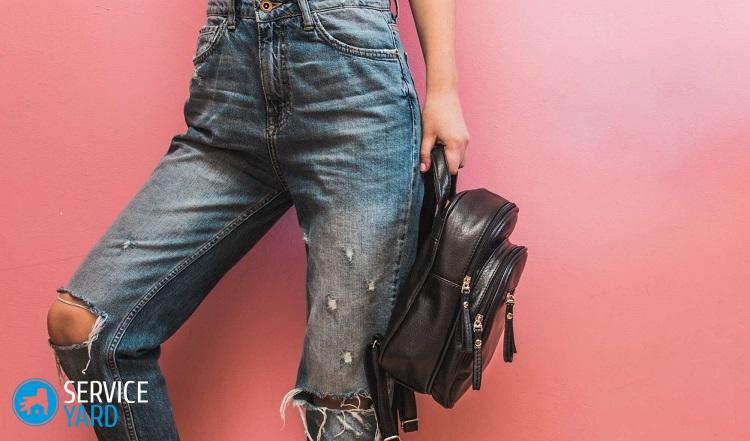
- Wash and iron your jeans and patch fabric to avoid wrinkling.
- Take a ripper (you can use nail scissors), open the crotch seam and the middle seam to the middle or slightly less.
- Mark up with chalk to determine which part you will cut (the damaged part should be completely behind the line).
- Use a ruler to draw straight lines symmetrically on both legs. Draw another line 1 cm further for the seam allowance.
- Cut along the first line. Cut the same piece on the second leg. Check that everything is the same, correct.
- Attach the cut pieces to the paper, circle them with a pencil and make an insert pattern.
- Where the patch will be sewn onto the jeans, make a 1 cm allowance per seam.
- Attach this pattern to a piece of denim, circle it with chalk and cut it out.
- Place the detail for the second leg to the fabric in a mirror-like manner.
- Now baste neatly evenly, and then sew the inserts to the edges of the jeans with blue threads, and the crotch and middle seams with a thread of the appropriate tone (yellow, orange).
If all else fails, you will have to buy new pants, and use the material on the old ones for sewing other things or useful things for the home. When buying, you can look for the same model, or you can diversify your image a little by choosing a more fitting version from the review of fashionable jeans styles this year.
Jeans are universal trousers for men, women and children that can be worn in any situation and combined with different clothes, skillfully expressing the style direction. However, even expensive, good quality denim pants are prone to wear and tear, resulting in scuffs and even holes. Most often, this requires the owner of the ability to correctly sew up a hole. If such a problem arises, do not despair of throwing away your favorite thing. Even a novice needlewoman can quickly and discreetly sew jeans between the legs.
How to fix jeans that have been rubbed between your legs by hand? "Manual resuscitation"
This can be done with a neat patch. This will require a thread with a needle and a small piece of denim.
It is important that the thread is strong enough to withstand the thickness of the denim material. As for a piece of fabric, experienced needlewomen often leave it "in reserve", retaining the cuts when shortening the length of denim trousers
If this is not your option, find a piece of another jeans that is as similar in color as possible.
The process of applying a patch for a scuff is as follows: the jeans are turned inside out, ironed, a piece of prepared fabric is applied to the problem area (it should be larger than the hole in size) and sewn. Then the problem area, duplicated with a patch, is covered with a needle.
This method is suitable for those who do not have a sewing machine at home, but if you have one, work can be done on it. You can also achieve a neat and lasting result by hand. The main thing is to choose the right thread so that it does not burst during the darning process. Fortunately, sewing shops now offer a wide variety of threads for those who love to work with denim. The so-called reinforced threads, based on a polyester thread with a cotton braid on top, have proven themselves very well.
How to fix jeans between your legs with a sewing machine
If you have home sewing equipment and know how to use it, then the jeans worn between the legs will be brought back to life by the method of sewing on the insert. To do this, you need patches in tone and threads of two shades: the first - in the color of jeans, the second - in the color of delaying the seams on their surface.
As in the previous version, patches are cut in advance, the size of which exceeds the worn space. On the side stitches and the back seam running in the center, the trousers are unstitched, a piece of fabric is carefully cut out on which the abrasion has formed. The cut off part is applied to the patches, outlined and cut out taking into account the seam allowance. Then all the parts are put together and a straight machine stitch is used to finish the jeans. It turns out very beautifully, and most importantly - reliably and unobtrusively!
You can experiment while sewing on the insert by replacing the jeans with a contrasting fabric, such as leather or corduroy, to prevent rubbing in these areas. To make such inserts "not striking", you can make similar stripes in other places, even where there are no holes. With a little imagination, you can not only repair jeans, but also turn them into a unique designer model!
If repair is not possible
It so happens that it is impossible to fix torn jeans, but you can find a way out of any situation! For example, you can make short "torn" shorts out of them! And from the remnants of the cut fabric, make accessories - a phone case, a handbag, a strap, a brooch, etc.
This advice is more suitable for young girls or little girls, but women and men can also take it into account.
If the courage allows, then the jeans worn between the legs can be "pulled up" to the end, adding slots, holes, scuffs in whole places, thereby turning the disadvantage into a "highlight". Ripped jeans have been at their peak for several seasons, so why not take advantage of the situation if there is no other solution to the problem? Of course, in this case, you won't wear jeans to work, a meeting or in a cafe, but they will still serve as clothes for recreation in nature.
Secrets Revealed - Now you know how to fix jeans worn between the legs. But try not to let wear to the holes. The sooner the abrasion that has arisen is repaired, the less painstaking the process will be and the more accurate the result.
Stage 1: What you need

- A pair of damaged jeans
- Another pair of unwanted old jeans or a scrap of material from them
- Needle
- Polyester thread of the required color
- Safety pins
- Scissors
If you are thrifty enough, you probably have an unnecessary pair of jeans in the right color in your closet. I am not so perspicacious and always threw them away, I will not do this anymore!
You can definitely do the job better than me if you can find repair jeans in the same color. As you can see in the photo, my color is slightly different.
It is highly advisable to use a polyester thread, as it stretches very well, while a 100% cotton thread will most likely not withstand stress. We can find them on sale at reasonable prices, in extreme cases, you can order from China.
How to fix frayed jeans between your legs: do it yourself
Hello dear craftswomen!
Today, I propose to talk about jeans and learn how to fix frayed jeans between the legs. Jeans are so firmly entrenched in our lives that we cannot imagine how we can do without it.
The only difference is that if earlier it was one of the most durable materials (remember that denim was created for workwear), now it is quite weak.
Why weak? It is dyed, whitened, lycra is added ... All these manipulations make the denim thread weak, it frays and breaks.
Now, of course, it is fashionable to walk with torn jeans, but not in all places)))) Therefore, people are forced to strengthen places that are quickly wiped, they put patches, spend money, repair jeans between their legs ...
In our piggy bank of master classes, we learned how to reduce jeans at the waist. Today, I want to show you the method that I use when rubbing denim.
If the product was not brought to a specific hole, then you can repair and strengthen the jeans between the legs in such a way that it will not be visible at all. If there is a hole and the place is heavily rubbed, this method is also suitable for this option, only to make it completely invisible is unlikely to work, but that it will strengthen is definitely.
What we need:
- Non-woven (fabric)
- Scissors
- Iron
- Sewing machine threads No. 50-60
- Sewing machine
- Machine needle No. 90
As you can see in photo 1, on one half the hole is visible, and on the other half, a strong abrasion is visible. What are we doing?
Progress
We turn the product over to the wrong side, take two pieces of non-woven fabric, put it on the hole and wipe with the glue side and sprinkle it with steam or spray it with water (depending on what kind of iron you have) and glue it. Photo 2.
In this way, we strengthen this place. You can also put fabric on top of the non-woven fabric, sweep it. This option will strengthen the problem area even more, but it can rub when worn and you will be uncomfortable. You decide.
We turn the product to the front side
With soap or chalk, we outline the boundaries of our patch (clearly seen in photo 5). An important part of the work is the selection of threads by color, focusing on the color of the worn
We take several coils of matching color, fold the thread several times and put it on the "sore spot"))) Look at photo 3, the threads from the small coil are not visible at all, but from the large one they are much more noticeable. Which we choose is already clear, of course a small coil.
We thread the sewing machine with selected threads, set the machine step at designation 2, less often 3.
It is important to choose the correct direction for the stitching - this is the slanting hem on the denim. If the line falls into it, the patch will not be visible at all
Photo 4
We sew forward - backward (we use the reverse of the machine). We lay a line near the line and so on the whole piece. We try to get into the rib on the fabric. Photo 5-6.
We iron the place to be restored with an iron. Everything! Job is done.
As you can see in photo 7, the lines are almost invisible.
If you have any questions or want to get advice on which method to choose, write.
I will be happy to help, advise and advise.)))
Good luck to you!
Write in the comments how you did it)))
Subscribe to receive new publications. Share information with your friends.
All the best to you. See you friends! Ilona was with you
If this master class was useful to you, light the heart)))
Reasons why jeans rub between the legs
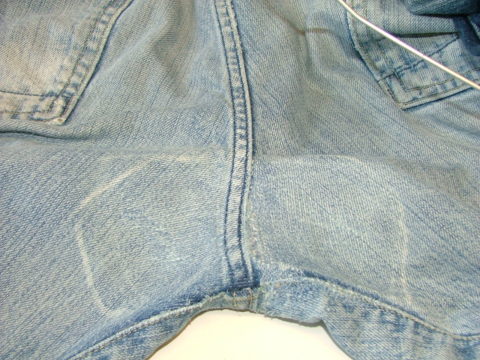
Jeans can rip in the area between the legs for several reasons:
- As professional tailors say, trousers are most often wiped due to the peculiarities of a person's figure.This almost always applies to the inner thighs. The fuller the hips, the more often you will have to visit clothing stores in search of new pairs of pants. Overly inflated hips can also cause holes in the area between the legs.
- Being overweight plays an important role. After all, it is he who affects the volume of the hips. The fabric stretches and starts to fray pretty quickly as you walk. Wrinkles can form between the legs on jeans, which will cause scuffs to form.
- The peculiarity of the gait is another reason for our problem. If in the process of walking the legs rub against each other, then “wait for holes”. But, most often in such a situation, only the seam will be wiped, and not the formed folds.
- The quality of the fabric can also cause the hole to appear. So, thin denim will quickly become unusable. And especially those models that already have artificial scuffs. It is better to buy fabric with the addition of elastane or polyester.
- Some people have a habit of fidgeting while sitting. And if you work in a seated position most of the day, then during the change of position the fifth point will definitely rub against the chair.
- Improper washing, the rate of wear of a certain material also play an important role.
4 Required materials:
- a patch of the right size, made of a soft material (or use shreds of the same jeans, or glue doublerin with a fabric base);
- chalk or remnant (to create a markup), scissors, a sewing needle;
- threads of high strength (select the threads so that they match the shade of the jeans).
Perform the work according to the following scheme.
Before sewing on a piece of fabric, wash the jeans, flatten the fabric with a hot iron
Pay special attention when ironing the upper part, where wrinkles and folds are constantly formed.
Turn your denim pants inside out.
Cut a piece of suitable fabric, matching its size and shape with the parameters of the damaged area of the jeans. The patch should completely cover the problem area
Do not forget about a small (1-2 cm) seam allowance.
If your jeans patch is made of glue dublerin with a fabric backing, you can fix it on the denim by simply attaching it to the damaged area and ironing it with an iron. When making a patch out of regular fabric, attach it to the inside of the jeans with a basting line. Make a rough seam with high quality so that at the time of creating a decorative stitch, the patch does not move to the sides.
The patch is locked and you can now turn the trousers inside out and make many stitches on a typewriter or by hand on the outside of the patch. The latter option will take much longer. If you are unable to repair denim pants yourself, take them to a tailor shop. Experts will repair frayed jeans by making a beautiful stitching on a typewriter.
When creating a decorative stitch on a home machine, shape it from the area where the denim has not yet been frayed. Place each new line as close as possible to the previous one.
After all stitches have been sewn in one direction, turn the fabric and sew a new stitch perpendicularly.
On the other leg of the denim pants, do the same job of securing the patch.
Method number 2
Another method of solving the problem associated with the appearance of abrasions in the crotch area is based on placing an insert on an area with worn and torn tissue. You will need:
- seam stripping tool;
- sharp scissors;
- a small piece of white chalk;
- pattern sheet;
- a pen;
- two types of threads (to match the jeans themselves, and a little darker to match the seams);
- A piece of denim that is similar in color to a denim that needs repair.
The steps for doing the job are described below.
- Wash and iron your jeans without leaving any creases in the crotch area.Do the same with the prepared denim patch.
- Use a special tool (ripper) or nail scissors to open the midsection and crotch seams.
- Using the chalk, make the markings, along which you will then cut the patch. Damaged areas on jeans must be completely behind the scoring line.
- On both legs of the jeans, draw straight and symmetrical scribing lines. To make it easier, use a ruler. Make another line or seam allowance, departing from the already drawn 1 cm.
- Cut the 1st line on each leg of the denim pants. If any irregularities remain, correct them. Both cuts should be symmetrical.
- Use the cut pieces of fabric to form the pattern on the paper. Just attach them to a white sheet, trace with a pencil and cut the resulting product with scissors along the contour.
- Be sure to make a seam allowance (1 cm on each side) where the insert will be sewn to the jeans fabric.
- Apply the finished pattern to the cut pieces of jeans fabric, circle with chalk and cut along the contour.
- Apply the pattern for the second leg to the fabric in a mirror-like manner. At the edges, process such inserts with a zigzag seam (use a sewing machine to create it). This is to prevent thread scattering.
- Now you just have to smoothly and neatly form the basting seam, and then sew the inserts to the jeans fabric. Use blue thread for this purpose so that the seam does not stand out too much. At the location of the middle and step seams, the inserts need to be sewn with threads of the appropriate shade (more often yellow or orange).
Methods for repairing trousers between the legs
So how do you fix a pair of pants that are frayed between your legs? There are two main ways to bring your pants back to their original look. Each of them is described in detail below.
Mend my pants by hand
This method is suitable for light scuffs on denim. To do this, you will need threads that are similar in thickness to the fibers of denim material. Also, the threads must be of the same color and shade, otherwise the place in which they are sewn will be conspicuous.
Secure a seam over the undamaged area of the fabric and pass the thread over the worn area with small stitches. Then the fabric will not be skewed. Then sew across the stitches, passing the needle between the threads. It should look like weaving new fabric instead of worn one. The better the threads are selected and the denser the seam, the less noticeable and durable the result of the work will be.
How to patch the pants between the legs?
Repairing trousers with a patch on the wrong side is called a "piece". This requires a special patch fabric. There are two types of it: one can be ironed to the trousers, the other will have to be sewn by hand. If the hole in the pants is small, then any color will do. Otherwise, you will have to choose a color to match the trousers. You will also need, as in the previous case, plain threads.
Step-by-step instructions for installing the patch:
First, turn your jeans inside out and look for a frayed or hole.
Cut out a piece of patch material so that it is slightly larger than the worn area.
If the fabric is flat with an iron, then after setting the required temperature and turning on the steam treatment, carefully put a patch from the inside of the trousers.
Attention! After gluing the patch, there should be no folds in this place. To do this, pre-wash your trousers and repair them while they are slightly damp.
If we are talking about a small hole in jeans, then from the front side, over the patch, you can stitch with plain threads (as in the first method)
In this case, the patch will help the seam to live much longer.
Darning will not work for repairing pants made from a different type of fabric.The invisibility of the patch will be affected only by the correctly selected shade of material and threads.
What if the pants are rubbing between the legs?
So, having understood the causes of scuffs between the legs and how to eliminate them, it is also necessary to mention how to avoid them. A few simple guidelines will help you with this.
What to do to avoid or reduce this effect:
- Choose more wear-resistant materials for trousers;
- Order more than one pair of trousers for one suit;
- Wear underwear boxers;
- Choose trousers with a more loose fit;
- Give your trousers a rest, wear them no more than once every two days;
- Choose pants with a ley.
Another reason is the peculiarity of the gait. If the volume of the hips is small, but the legs still rub against each other when walking, then the crotch seam of the trousers will wear out rather quickly and the trousers will have to be repaired. To avoid rubbing, you must constantly monitor your gait. Over time, this will become a habit and no longer cause discomfort.
When sedentary work or lifestyle, try to fidget less in your chair. To change body position, raise yourself slightly from the chair. This will help reduce the amount of friction.
When choosing jeans, try not to buy low-waisted models. As a rule, on such models, when worn, folds form between the legs, which can lead to unnecessary holes. Buy jeans with a normal or slightly high fit.
Do not wash your pants too often, this will noticeably shorten their lifespan. When washing, try to use as little household chemicals as possible (rinses, stain removers, conditioners). It will be preferable to wash by hand, treating the stains with laundry soap and water. You can also use the delicate mode in the washing machine.

Watch the thickness of the fabric on the pants between the legs. If it has become too thin, then soon it will inevitably be rubbed. In this case, you can strengthen the weak areas yourself with the help of pads or contact this task in the atelier. In any case, it's better than patching worn pants later.
Don't wear the same pants all the time. Buy two or three pairs and change your jeans every few days. Then the problem of wiping will bother you much less often.
It is necessary to understand that an unwanted hole or scuff can be removed on your own. If your pants are completely worn out, maybe it's time to get a new pair, and make shorts out of old pants or use them during car repairs or construction work.

Share on social media networks:
Jeans are comfortable clothes that can be easily combined with many things and different shoes. For most, this is the most favorite and frequently used part of the wardrobe. In the process of prolonged wear, the bottom of the legs breaks down, which is not so difficult to restore. Probably, every third person gets in trouble when the jeans are wiped between the legs, what to do in such a situation? Does the duration of wearing jeans depend on their value, brand, style? Is there anything you can do to prevent these rubbed spots between your legs from appearing so quickly? These questions are often asked on forums. In response, someone advises not to skimp and buy jeans at a higher price, someone advises to put a leather pad in advance, like cowboys, and someone recommends losing weight. We will try to understand the reasons for this unpleasant situation and offer you different solutions to the problem, how to fix or restore jeans that have come apart between the legs.


